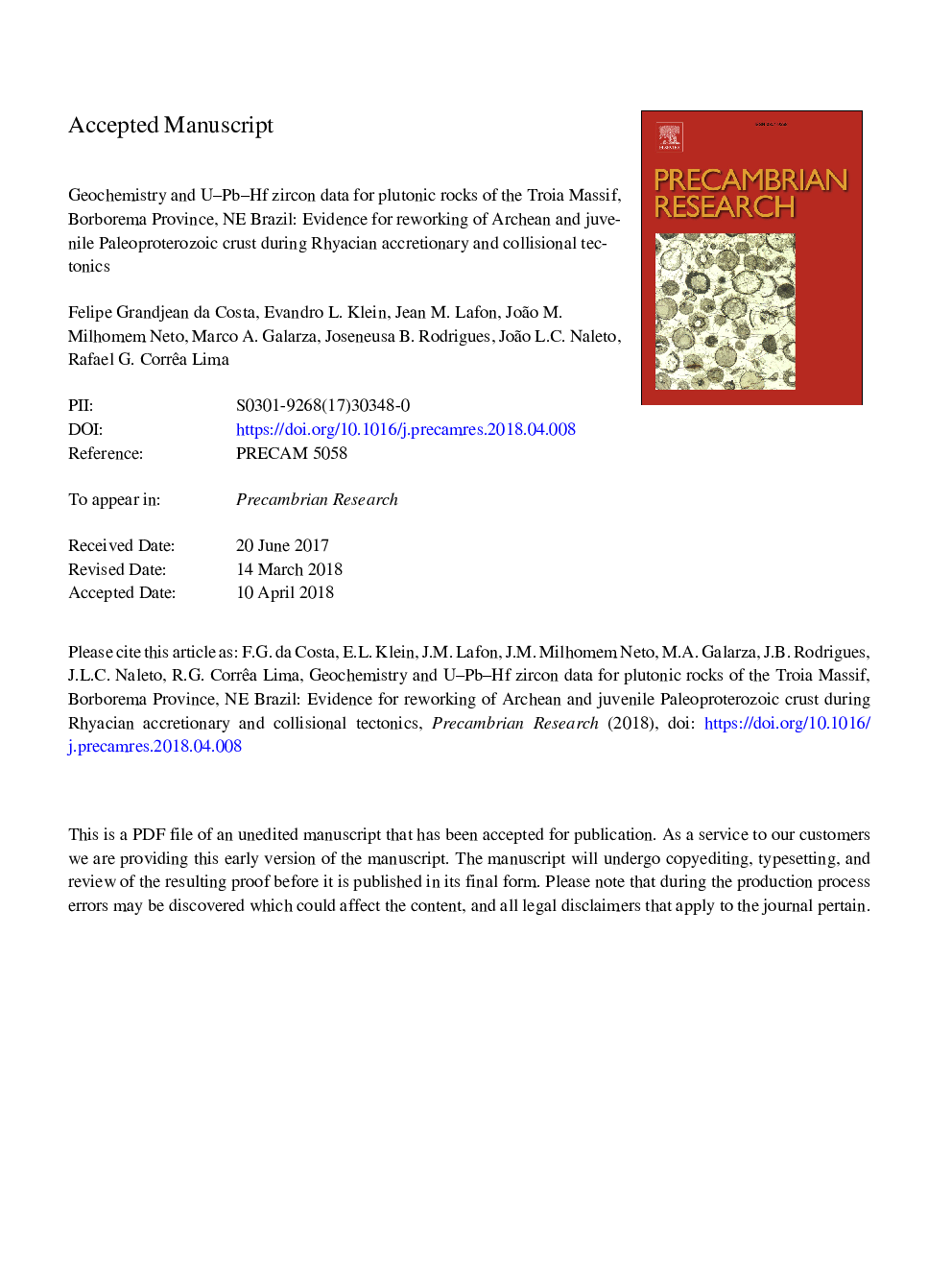| کد مقاله | کد نشریه | سال انتشار | مقاله انگلیسی | نسخه تمام متن |
|---|---|---|---|---|
| 8912553 | 1639564 | 2018 | 54 صفحه PDF | دانلود رایگان |
عنوان انگلیسی مقاله ISI
Geochemistry and U-Pb-Hf zircon data for plutonic rocks of the Troia Massif, Borborema Province, NE Brazil: Evidence for reworking of Archean and juvenile Paleoproterozoic crust during Rhyacian accretionary and collisional tectonics
دانلود مقاله + سفارش ترجمه
دانلود مقاله ISI انگلیسی
رایگان برای ایرانیان
موضوعات مرتبط
مهندسی و علوم پایه
علوم زمین و سیارات
ژئوشیمی و پترولوژی
پیش نمایش صفحه اول مقاله

چکیده انگلیسی
Rhyacian (c. 2.30-2.05â¯Ga) subduction-accretion and collisional processes are thought to represent an important event of crustal growth and reworking, often reported in the so-called Tranzamazonian/Eburnean granite-greenstone terranes of N/NE Brazil and West African craton. In this work, we present whole-rock geochemistry and U-Pb-Hf zircon ages for Rhyacian plutonic rocks that intrude Paleoproterozoic granite-greenstone terranes and Archean basement rocks of the Troia Massif, Borborema Province, NE Brazil. U-Pb SHRIMP zircon age of 2185â¯Â±â¯4â¯Ma was obtained for a metatonalite sample (Mirador metatonalites). The metatonalites show geochemical affinity similar to those of adakites-like rocks, with all “classic” (slab-derived) adakitic signature (e.g. high Sr/Y, La/Yb and low HREE), but more akin to those evolved from partial melting of the metasomatized mantle wedge, followed by fractional crystallization. Zircon Hf crustal model ages of the metatonalite sample range between 2800 and 2660â¯Ma, evidencing that Archean crustal components contributed to its magma genesis, probably via subduction of continental-derived sediments to the mantle wedge. For potassic plutons of the Troia Massif (Bananeira suite) we obtained U-Pb SHRIMP zircon age of 2079â¯Â±â¯4â¯Ma for a deformed quartz-monzonite with geochemical affinities similar to those derived from low-pressure partial melting of a K-rich mafic protolith. For less-deformed equigranular granites, we obtained a U-Pb LA-ICPMS zircon age of 2068â¯Â±â¯5â¯Ma. They are high-K calc-alkaline and slightly peraluminous granites that probably derived from low-pressure partial melting of tonalitic crustal sources (metatonalites) and/or metagraywackes. Zircon Hf crustal model ages of a granite sample range from 2713 to 2535â¯Ma, evidencing Archean crustal contribution to magma genesis. However, two analyzed c. 2307â¯Ma inherited zircon grains show εHf(t) values of c. +4.87, indicating that crustal reworking of less-radiogenic Paleoproterozoic sources also participated in its genesis. Regional correlations of our results with the Paleoproterozoic record of the Troia Massif, Borborema Province and surrounding cratonic domains, suggest that the studied plutons are related to the c. 2.2-2.0â¯Ga Transamazonian/Eburnean orogenic cycle. The c. 2185â¯Ma metatonalites are associated to pre-collisional setting, while the c. 2079-2068â¯Ma quartz monzonites and granites evolved during collisional setting.
ناشر
Database: Elsevier - ScienceDirect (ساینس دایرکت)
Journal: Precambrian Research - Volume 311, July 2018, Pages 167-194
Journal: Precambrian Research - Volume 311, July 2018, Pages 167-194
نویسندگان
Felipe Grandjean da Costa, Evandro L. Klein, Jean M. Lafon, João M. Milhomem Neto, Marco A. Galarza, Joseneusa B. Rodrigues, João L.C. Naleto, Rafael G. Corrêa Lima,